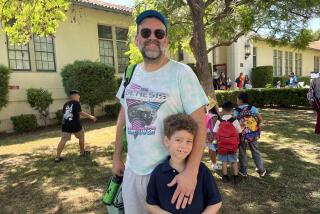CANOGA PARK : Tension Builds in a Phone Call to Outer Space
- Share via
All systems were go with the space shuttle amateur radio experiment.
All the extra wiring for the telephone lines and the radio antennas had been completed. The three-way teleconference call to Goddard Space Flight Center in Maryland and a San Diego amateur radio station was coming in clearly.
Monitoring the shuttle tracking system, Giamaica Zeidler, 9, pointed out a minor complication: “The tracker is off half a world,” she said, then quickly calculated the difference to establish that the shuttle was orbiting over the western coast of Africa at that moment.
The experiment Wednesday night was to make contact with an astronaut aboard the space shuttle Endeavour using amateur, or ham, radio.
The participants were students at Fullbright Avenue Elementary School in Canoga Park, one of 26 schools worldwide and the only one in the Los Angeles Unified School District selected to participate.
For the last four months, the Fullbright students had been researching astronomy, space technology and ham radio operation in preparation for the try Wednesday night.
They had been invited to submit questions they would like to ask the astronauts, and 10 youngsters had been selected to read them.
Doreen Aghajanian, a fourth- and fifth-grade teacher at Fullbright, was coordinating the contact. A ham radio buff, Aghajanian had arranged the event so that as much of the school community as possible could be involved.
The auditorium was packed with students, parents and teachers Wednesday night, nervously waiting to see if the attempt would succeed.
Aghajanian warned the audience that “This is only an experiment” and that there was a good chance it wouldn’t work. Other schools that tried had made contact long enough for only one question, she said.
After about 20 minutes of setting up the call, the San Diego amateur radio station began the attempt to talk with Wendy Lawrence, the astronaut aboard Endeavour who had the assignment to answer the questions.
In the auditorium, the effort could be heard through a public address system. Static was the only response at first. Aghajanian was visibly worried, and the audience waited, silent, nervous.
And contact was made at 8:36 p.m.
The first question was asked by Kelly Baxter, 10, who wanted to know if Lawrence had experienced any change in her pulse or blood pressure.
Lawrence said she had not.
Next, Ali Sheaffer, 7, asked if there had been any change in Lawrence’s body out in space.
Lawrence replied that because of the lack of gravity all the fluids that usually settle at her feet were up in her head, making her feel as if she had a cold. She added that her lower back hurt because her spine was stretched out and that she was actually a little taller in space.
One by one, the youngsters asked the astronaut about what it’s like to be in space.
At 8:42, as Brett Mason, 7, asked his question, the line went dead.
“We are L.O.S.” (loss of signal), announced Aghajanian.
Jim O’Donnell, a ham operator who helped set up the event with Aghajanian, called the contact “unbelievable.”
O’Donnell’s son had participated in a similar experiment five years ago and that contact had lasted only a few minutes.
“I hadn’t heard one like this,” he said.
More to Read
Sign up for Essential California
The most important California stories and recommendations in your inbox every morning.
You may occasionally receive promotional content from the Los Angeles Times.













